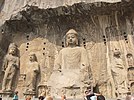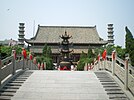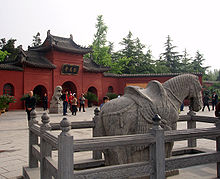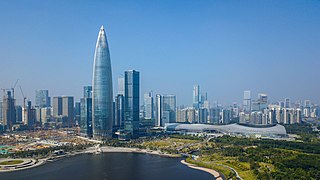
Guangdong, formerly romanized as Kwangtung or Canton, is a coastal province located in South China, on the north shore of the South China Sea. The provincial capital is Guangzhou. With a population of 126.84 million across a total area of about 179,800 km2 (69,400 sq mi), Guangdong is the most populous province of China and the 15th-largest by area as well as the third-most populous country subdivision in the world.

Hebei is a province in North China. Hebei is China's sixth most-populous province, with over 75 million people. Shijiazhuang is the capital city. The province is 96% Han Chinese, 3% Manchu, 0.8% Hui, and 0.3% Mongol. Varieties of Chinese spoken include Jilu Mandarin, the Beijing dialect of Mandarin, and Jin Chinese.

Hubei is an inland province of China, and is part of the Central China region. The name of the province means "north of the lake", referring to its position north of Dongting Lake. The provincial capital, Wuhan, serves as a major transportation hub and the political, cultural, and economic hub of central China.

Anhui is an inland province located in East China. Its provincial capital and largest city is Hefei. The province is located across the basins of the Yangtze and Huai rivers, bordering Jiangsu and Zhejiang to the east, Jiangxi to the south, Hubei and Henan to the west, and Shandong to the north. With a population of 61 million, Anhui is the 9th most populous province in China. It is the 22nd largest Chinese province based on area, and the 12th most densely-populated region of all 34 Chinese provincial regions. Anhui's population is mostly composed of Han Chinese. Languages spoken within the province include Lower Yangtze Mandarin, Wu, Hui, Gan and small portion of Central Plains Mandarin.

Liaoning is a coastal province in Northeast China that is the smallest, southernmost, and most populous province in the region. With its capital at Shenyang, it is located on the northern shore of the Yellow Sea, and is the northernmost coastal province of the People's Republic of China.

Shaanxi is an inland province in Northwestern China. It borders the province-level divisions of Shanxi, Henan (E), Hubei (SE), Chongqing (S), Sichuan (SW), Gansu (W), Ningxia (NW), and Inner Mongolia (N).

Jiangsu is an eastern coastal province of the People's Republic of China. It is one of the leading provinces in finance, education, technology, and tourism, with its capital in Nanjing. Jiangsu is the third smallest, but the fifth most populous and the most densely populated of the 23 provinces of the People's Republic of China. Jiangsu has the highest GDP per capita and second-highest GDP of Chinese provinces, after Guangdong. Jiangsu borders Shandong in the north, Anhui to the west, and Zhejiang and Shanghai to the south. Jiangsu has a coastline of over 1,000 kilometers (620 mi) along the Yellow Sea, and the Yangtze River passes through the southern part of the province.

Luoyang is a city located in the confluence area of the Luo River and the Yellow River in the west of Henan province. Governed as a prefecture-level city, it borders the provincial capital of Zhengzhou to the east, Pingdingshan to the southeast, Nanyang to the south, Sanmenxia to the west, Jiyuan to the north, and Jiaozuo to the northeast. As of December 31, 2018, Luoyang had a population of 6,888,500 inhabitants with 2,751,400 people living in the built-up area made of the city's five out of six urban districts and Yanshi District, now being conurbated. By the end of 2022, Luoyang Municipality had jurisdiction over 7 municipal districts, 7 counties and 1 development zone. The permanent population is 7.079 million.

Kaifeng is a prefecture-level city in east-central Henan province, China. It is one of the Eight Ancient Capitals of China, having been the capital eight times in history, and is most known for having been the Chinese capital during the Northern Song dynasty.

Zhengzhou is the capital and largest city of Henan Province in the central part of the People's Republic of China. Located in northern Henan, it is one of the National Central Cities in China, and serves as the political, economic, technological, and educational center of the province. The Zhengzhou metropolitan area is the core area of the Central Plains Economic Zone.

Nanyang is a prefecture-level city in the southwest of Henan province, China. The city with the largest administrative area in Henan, Nanyang borders Xinyang to the southeast, Zhumadian to the east, Pingdingshan to the northeast, Luoyang to the north, Sanmenxia to the northwest, the province of Shaanxi to the west, and the province of Hubei to the south.

Anyang is a prefecture-level city in Henan, China. The northernmost city in Henan, Anyang borders Puyang to the east, Hebi and Xinxiang to the south, and the provinces of Shanxi and Hebei to its west and north respectively. Anyang had a total population of 5,477,614 as of the 2020 census, 2,675,523 of whom lived in the built-up area made of four urban districts and Anyang and Tangyin counties, now largely agglomerated with the city proper.

Xinxiang is a prefecture-level city in northern Henan province, China.

Xuchang is a prefecture-level city in central Henan province in Central China. It is bordered by the provincial capital of Zhengzhou to the northwest, Kaifeng to the northeast, Zhoukou to the east, Luohe to the southeast, and Pingdingshan to the southwest.
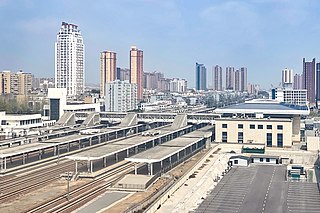
Jiaozuo is a prefecture-level city in the northwest of Henan province, China. Sitting on the northern bank of the Yellow River, it borders the provincial capital of Zhengzhou to the south, Xinxiang to the east, Jiyuan to the west, Luoyang to the southwest, and the province of Shanxi to the north. Jiaozuo is one of the core cities of the Central Plains urban agglomeration and a regional central city along the Shanxi–Henan border area.

Shangqiu, alternately romanized as Shangkiu, is a city in eastern Henan province, Central China. It borders Kaifeng to the northwest, Zhoukou to the southwest, and the provinces of Shandong and Anhui to the northeast and southeast respectively. Its population was 7,816,831 inhabitants as of the 2020 Chinese census whom 2,831,814 lived in the built-up area made up of two urban districts and Yucheng county now being conurbated.

Zhoukou is a prefecture-level city in eastern Henan province, China. It borders Zhumadian to the southwest, Xuchang and Luohe to the west, Kaifeng to the northwest, Shangqiu to the northeast, and the province of Anhui on all other sides. As of the 2020 census, its population was 9,026,015 inhabitants. However, as of the 2018 estimation, 1,601,300 lived in the built-up made up of Chuanhui district and the northern part of Shangshui county.

Runan County is a county under the administration of the prefecture-level city of Zhumadian, in the southeast of Henan Province, China.

Yuzhou is a county-level city in the central part of Henan, People's Republic of China. Yuzhou City, referred to as "Jun", was called Yangzhai, Junzhou and Yingchuan in ancient times, and also called Xiadu, Jundu and Medicine Capital.It occupies the northwest corner of the prefecture-level city of Xuchang. The city is named for Yu the Great, the founder of the Xia Dynasty, which the city's government claims was founded in present-day Yuzhou, and that the dynasty's capital was located in present-day Yuzhou. There is a statue of Yu the Great in Yuzhou, and he serves as a symbol of the city.
The COVID-19 pandemic reached the province of Henan, China on 21 January 2020.


